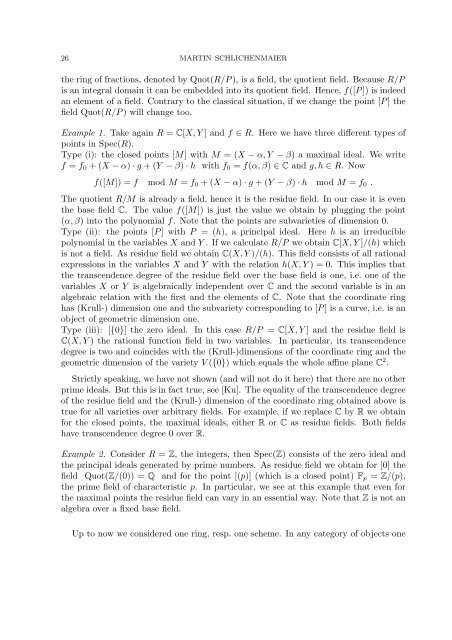Mannheimer Manuskripte 177 gk-mp-9403/3 SOME CONCEPTS OF ...
Mannheimer Manuskripte 177 gk-mp-9403/3 SOME CONCEPTS OF ...
Mannheimer Manuskripte 177 gk-mp-9403/3 SOME CONCEPTS OF ...
- No tags were found...
Create successful ePaper yourself
Turn your PDF publications into a flip-book with our unique Google optimized e-Paper software.
26 MARTIN SCHLICHENMAIERthe ring of fractions, denoted by Quot(R/P), is a field, the quotient field. Because R/Pis an integral domain it can be embedded into its quotient field. Hence, f([P]) is indeedan element of a field. Contrary to the classical situation, if we change the point [P] thefield Quot(R/P) will change too.Exa<strong>mp</strong>le 1. Take again R = C[X,Y ] and f ∈ R. Here we have three different types ofpoints in Spec(R).Type (i): the closed points [M] with M = (X − α,Y − β) a maximal ideal. We writef = f 0 + (X − α) · g + (Y − β) · h with f 0 = f(α,β) ∈ C and g,h ∈ R. Nowf([M]) = f mod M = f 0 + (X − α) · g + (Y − β) · h mod M = f 0 .The quotient R/M is already a field, hence it is the residue field. In our case it is eventhe base field C. The value f([M]) is just the value we obtain by plugging the point(α,β) into the polynomial f. Note that the points are subvarieties of dimension 0.Type (ii): the points [P] with P = (h), a principal ideal. Here h is an irreduciblepolynomial in the variables X and Y . If we calculate R/P we obtain C[X,Y ]/(h) whichis not a field. As residue field we obtain C(X,Y )/(h). This field consists of all rationalexpressions in the variables X and Y with the relation h(X,Y ) = 0. This i<strong>mp</strong>lies thatthe transcendence degree of the residue field over the base field is one, i.e. one of thevariables X or Y is algebraically independent over C and the second variable is in analgebraic relation with the first and the elements of C. Note that the coordinate ringhas (Krull-) dimension one and the subvariety corresponding to [P] is a curve, i.e. is anobject of geometric dimension one.Type (iii): [{0}] the zero ideal. In this case R/P = C[X,Y ] and the residue field isC(X,Y ) the rational function field in two variables. In particular, its transcendencedegree is two and coincides with the (Krull-)dimensions of the coordinate ring and thegeometric dimension of the variety V ({0}) which equals the whole affine plane C 2 .Strictly speaking, we have not shown (and will not do it here) that there are no otherprime ideals. But this is in fact true, see [Ku]. The equality of the transcendence degreeof the residue field and the (Krull-) dimension of the coordinate ring obtained above istrue for all varieties over arbitrary fields. For exa<strong>mp</strong>le, if we replace C by R we obtainfor the closed points, the maximal ideals, either R or C as residue fields. Both fieldshave transcendence degree 0 over R.Exa<strong>mp</strong>le 2. Consider R = Z, the integers, then Spec(Z) consists of the zero ideal andthe principal ideals generated by prime numbers. As residue field we obtain for [0] thefield Quot(Z/(0)) = Q and for the point [(p)] (which is a closed point) F p = Z/(p),the prime field of characteristic p. In particular, we see at this exa<strong>mp</strong>le that even forthe maximal points the residue field can vary in an essential way. Note that Z is not analgebra over a fixed base field.Up to now we considered one ring, resp. one scheme. In any category of objects one
















